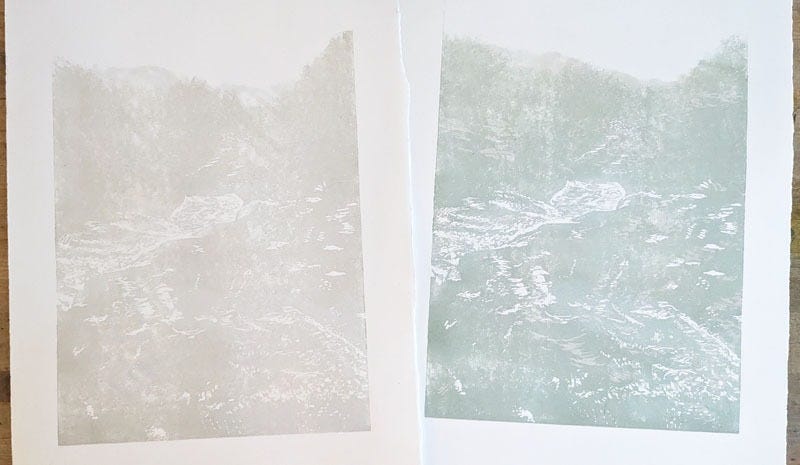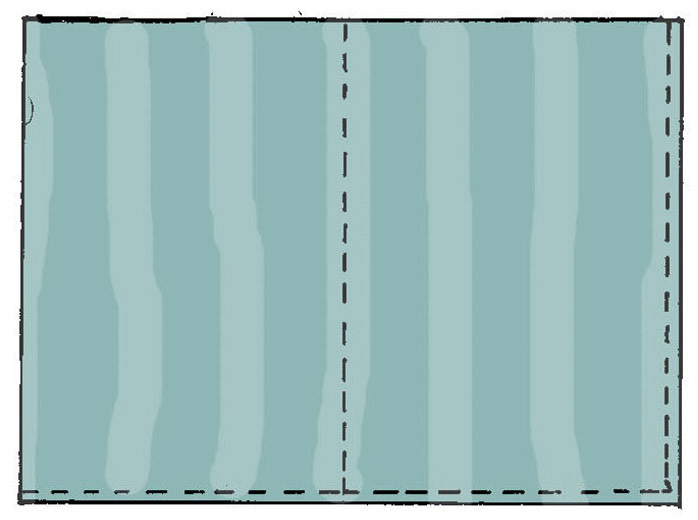First of all a quick update on my new ‘why on earth did I think moving water was a good idea’ print. It’s coming along slowly, with podcasts keeping me going through lots of fiddly carving. Here it is before and after of the most recent (fourth) layer. Sorry about the awful lighting, but it is relentlessly dull and grey here at the minute. The blank area at the top is where I have been masking out the sky. When I eventually print that layer I don’t want the clear fresh blue of the sky to be dulled by the pale greys and teal already printed so it needs to be on clean unprinted paper.
I mentioned when I last wrote that I would let you know if switching from plywood to MDF for my new registration jig would solve the problem of the uneven ink. Well, up to a point… (and if you mentally added the words ‘Lord Copper’ to that you are my kind of person).
Overall the transfer of ink has definitely improved, but equally definitely there are particular areas that are still causing trouble. There are persistent faint lines that run the length of the block (top to bottom on this print, from side to side on the last one which was landscape format) - two broad ones up the middle and also on the long edges. The badly made photoshop image below shows what I mean.
In fact now I’ve pointed it out you might be able to see it in the photo of prints at the start of this newsletter. Fortunately it’s not a disaster with this print to have uneven ink coverage - it might even be said to be an advantage when it is depicting nature, foliage, subtle shading and rushing water (did I mention the moving water?) - but if I were a printmaker working in crisp graphic shapes with just a few distinct colours it would be a catastrophe. So on the whole I would like to get to the bottom of it and have varied pressure and coverage where I choose to have it and not be at the mercy of an uncooperative block.
For some reason then, less ink is getting onto the paper in these areas. This could be because:
less ink is transferring from the roller to the block (a problem with rolling)
less ink is transferring from the block to the print (a problem with printing)
both (help)
I have found that rolling the ink from side to side (with the block in portrait format), rather than in long strokes from top to bottom, does help. This suggests that the lighter areas might be caused by actual dips in the lino. The sketches below show how turning the roller around would help get into a dip. (Obviously the dip is exaggerated).
This has improved things, suggesting there was indeed a problem with getting the ink onto the block. However it doesn’t fix it entirely; the lines are less visible but still there. This means there is also a problem with getting the ink onto the paper; possibly the press is not making equal contact all over or maybe there is something else weird about how the ink reacts with the block. Either way the common denominator in both stages is the lino block, so it seems that is where the issue lies.
Does the block really have dips and dents? If so they are invisible to the naked eye and they can’t be felt by finger tip which can normally detect the tiniest of changes. The parts picking up the ink better happen to be roughly in line with the three strips of double-sided tape sticking the block to the jig, but these can’t be more than 1mm deep and lino is stiff - surely it can’t make that much difference??
Perhaps it’s something about the lino itself? I cut my 20 x 30cm blocks from larger sheets which are a little over 40 x 30cm. I tend to stain and sand the larger sheets a couple at a time before cutting them up, and at some point last year I prepared two sheets and cut them into four blocks. This block is the last of the four, which means there is a one in three chance that both this block and the last one I used were from the same sheet. If you put them back together the faint lines would look like this.
Ooh… when you see it like that it does rather look like it might be something in the block itself, doesn’t it? Maybe the fact I have had trouble with these two prints is nothing to do with my new registration jigs.
So at the end of all this I am no further forward to be honest. For the time being I am rolling from side to side which is getting the ink onto the block evenly. Then after I have printed with my Sláma press I am pre-emptively going over the troublesome areas with a wooden spoon and baking parchment before I even pull back the print to have a first look. It’s less frustrating that way. I would like to find out what’s going on though. I will have to see what happens when I use a new sheet of lino (though it will be from the same batch, so who knows). Meanwhile if any printmakers, or industrial chemists, out there have any suggestions please do let me know.
Getting out of the studio
I got away from mysteriously behaving lino last weekend by making a trip to the Yorkshire Sculpture Park, which is one of our favourite places and always worth a visit. I particularly wanted to see Sarah Kirby’s current exhibition, ‘A Printmaker’s Landscape’, having long been an admirer of Sarah’s linoprints. As is my usual habit, I was the one standing 6 inches away from the prints peering at the technique and marks made, while others were standing further back and actually looking at the images. I’m afraid I do this with paintings, textiles and most forms of art, not only printmaking. I just find understanding the processes absolutely fascinating and love feeling a connection with an artist. To me there is little more exciting than seeing a brushstroke on a painting or a thumb print on pottery and knowing the artist made it with their own hand, watching it appear with their own eyes while their own thoughts were running through their head. And don’t get me started on hand prints in cave paintings - wow.
But anyway I do recommend a visit. I didn’t take any photos of the exhibition itself as there was a lot of reflection on the picture glass (it was a surprisingly sunny day), but you can get a taste of Sarah’s work on her website. The exhibition runs until 22nd February but if you can get there before the end of January there is a two-for-one offer on Yorkshire Sculpture Park admission when booked online. Use the code JAN2025 at checkout.
And now it’s back to more carving as, and I don’t know if I’ve mentioned this, there is a lot of that involved in depicting moving water.
Thank you for reading this far and listening to me as I wrestle with my uneven ink demons. See you again soon.
Jane










Just make a frisket and build the areas with tissue one sheet at a time. Perfectly sensible approach to printing water anyway… 😬
Sure it isn't the roller? Probably not because you'd likely have a phantom checkerboard. However I have had several 6-inch speedball rollers cave in the middle.